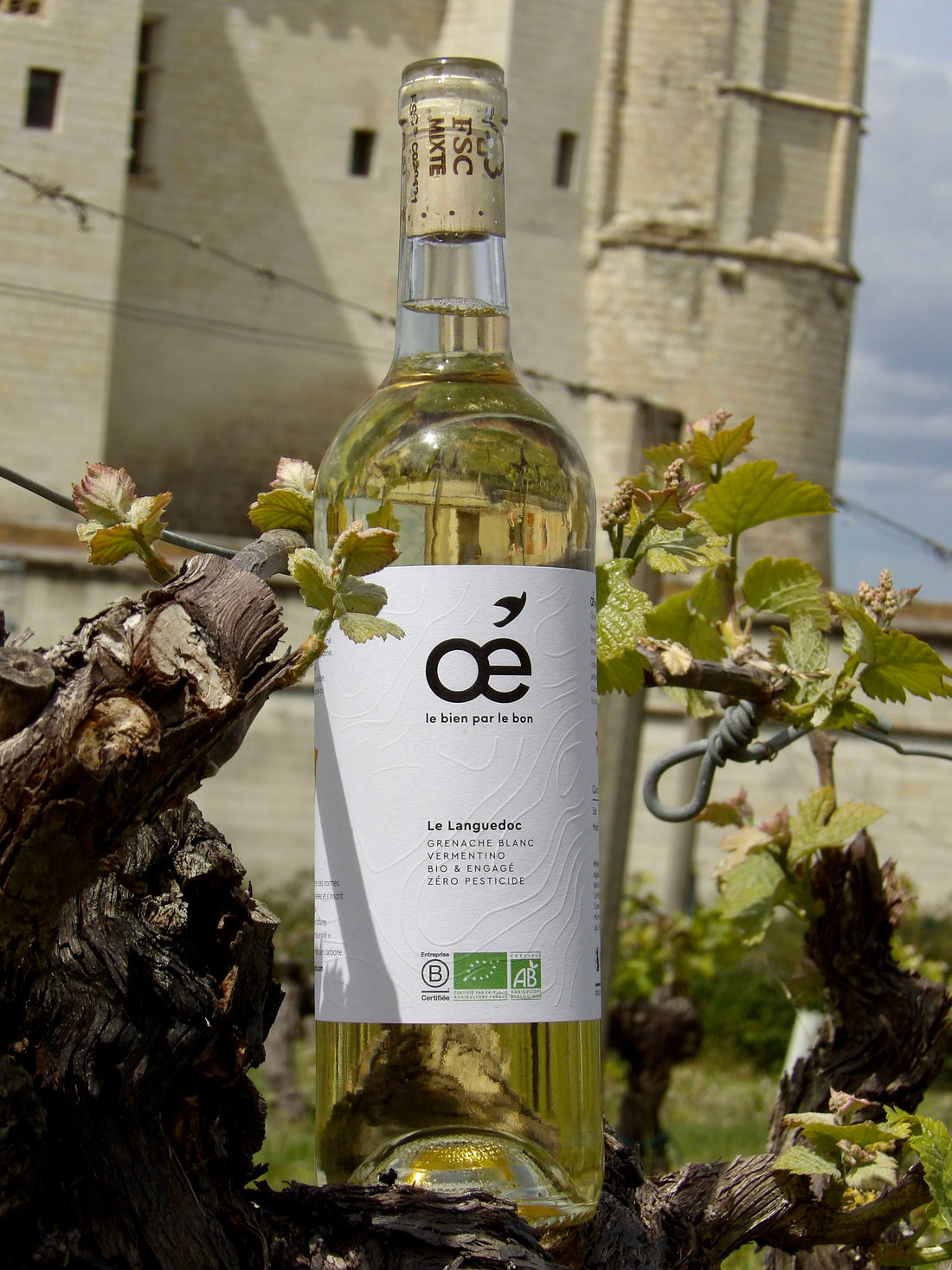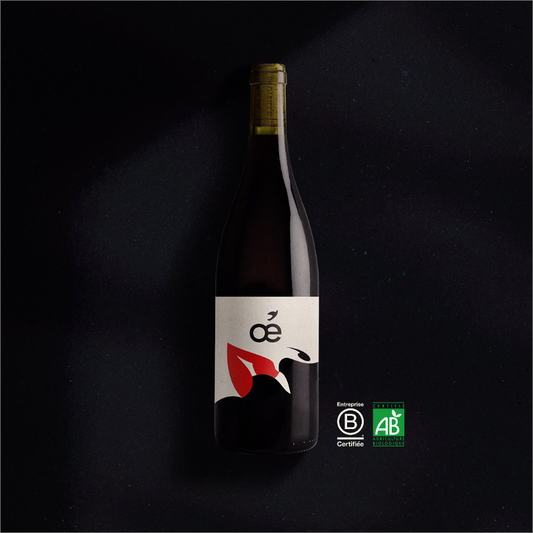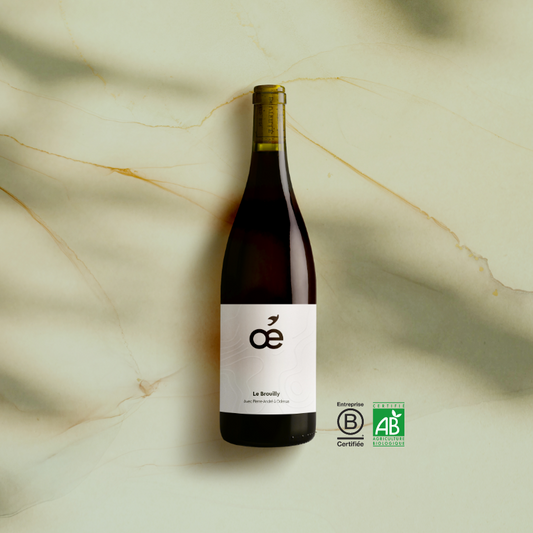Reading the title, do you expect an article that is not very sexy? Well imagine that soil maintenance can be exciting even without being passionate about agriculture! The proof, I ended up taking an interest in it (for those who don't know me, I'm Charlotte from com' at Oé) by dint of hearing about it from our Oé winegrowers . Because, yes, when visiting the winegrowers, we talk about wine, we taste but also and above all we do tours in the vineyards to better understand how biodiversity works;) Would you like to learn more about the subject? Follow the guide !
The different soil maintenance techniques in organic farming
Whether it is to produce organic wines , biodynamic wines or natural wines , the winegrowers pamper their vines to help them, thanks to the surrounding biodiversity, to arm themselves against parasites and diseases . And it is partly thanks to the maintenance of the soil that the vine produces such good grapes! The soil is one of the main elements of the terroir with the grape varieties, the climate and the exposure. Let's go for a tour of the techniques used on the soils cultivated organically, because the vineyards managed in conventional do not practice the same techniques as those in organic. Eh yes !

Root pralination
We see you coming gourmets, the praline is not made from praline sugar but from a mixture of clay, cow dung and water. Much less sexy but very practical, this technique consists of coating the roots before planting in winter while the vines are resting. This is a practice that was already carried out by our ancestors and which ensures that the sap rises well to the buds , and therefore, that it brings the right nutrients to the end of the vine shoots .
The uprooting of the vines
Sometimes, the winegrower has to uproot his vines if the grape variety or the rootstock that has been planted is not adapted to the terroir , if the plot is badly exploited and the vines do not give the expected yield . This technique traumatizes the soil and therefore must be done with care, when the soil is neither too dry nor too wet. The vines are then burned to prevent the spread of harmful insects or viruses in the field.
Weeding between the vines
Weeding is a practice that is increasingly used in organic vineyards . The whole thing is to make sure that the grass does not compete with the vine . Grass in competition... What does that mean? Like any plant, grass feeds on the nutrients present in the soil. This means that it can take nutrients that the vine will not have to develop if the grass is too present. There are therefore inter-vine brushes for weeding and cleaning the inter-rows to limit the risk of erosion .
Green manures in organic farming
We speak of green manure to characterize plants that are grown for the purpose of fertilizing the soil, and not to be harvested. Yes, it is with mutual aid that we manage to do great things and plants have understood this well. This can be likened to companionship , when the plants share the same land and exchange tips.
The roots of green manures help loosen the inter-row soil (which is between the rows of vines), i.e. make it lighter and easier to work, and improve penetration. water and air. Green manures are also very useful in winter. After the harvest, the vine has the right to a little rest. While it sleeps, green manures take over by storing elements and enriching the soil so that when it wakes up, the vine has everything it needs.
Vegetation covers
What is your first instinct in winter when you get into bed? Bundle up under your duvet, right? Well for the vines it's the same! The winegrower does everything to protect his vines , warm them as best he can and protect the soil from desiccation (when the soil cracks so dry or frozen). We reassure you, the winegrower does not weave a large woolen blanket for his vines, but he uses straw to create a cereal blanket and keep the heat in, for example. A natural solution to fight against extreme cold spells and prevent the vines from being frozen . At the end of winter, the winemaker uses manure to reactivate the soil and bring the vines back to life . Finally, the manure in the vines is a bit like Prince Charming who wakes up Sleeping Beauty. You got it, at Oé we love metaphors!
the lamb
The what? Yes, yes, you understood and probably correctly analyzed the word. When we talk about Sheep Mower, we are talking about shearing by sheep to replace gasoline mowers or electric mowers.
Be careful not to put the sheep anywhere, anytime and too long in the vines. For example, when the buds are in the process of coming out, they are very fragile and can fall off because of the sheep which rub against the vines while grazing or simply be eaten a little before flowering , because the sheep love them.

All these techniques make it possible in viticulture to limit phytosanitary products . In organic farming, Bordeaux mixture and sulfur are the two inputs authorized in small quantities. These are natural pesticides (to be differentiated from chemical pesticides) which are called trace elements. They allow the vine to protect itself against diseases such as Oidium or parasites such as Phylloxera .
Powdery mildew is a kind of white rot that attacks the bunches of grapes. This fungus develops less when the vines are well maintained and the spacing between the vines and vine shoots is sufficient to ventilate well and limit the humidity, which the fungus loves. A vine shoot is simply the branch of the vine once it is ligneous, that is to say, it takes on the appearance of wood. Leaf stripping helps prevent the spread of powdery mildew. Phylloxera are leaf-eating aphid pests that eventually turn yellow without killing the plant. Not very glamorous, that's why winegrowers try to protect themselves from pests and diseases upstream. Prevention is better than cure as they say!
The winegrowers will not maintain their soil in the same way depending on the rainfall, the type of soil, the slope of the vineyard depending on the region. Technical, socio-economic and environmental aspects come into play. Each winegrower takes into account the diversity of his vineyard and regional specificities.
If you are passionate about the vine, we advise you to meet the winegrowers to learn more about their profession. Wine tourism has become a must for wine enthusiasts, so let's go on the road together!
Maintenance of the vine in organic farming: other techniques
To obtain the AB label , the winemaker follows specifications from viticulture to viniculture , to produce a good organic wine , respectful of the environment.
Here are some small techniques of the winegrowers, which we share with you with pleasure:
- Limit yields with green harvesting . This technique makes it possible to reduce the quantity of grapes produced by the vine, to respect a certain yield according to the appellation. For example, in red Côtes-du-Rhône, you cannot exceed 50 hectoliters/hectare. And also so that the quality of the grapes is the best possible. And yes Jamy, when we reduce the number of buds, those that emerge and produce grapes are much more qualitative because they have been fed with more nutrients.
- Pruning the vines is generally done around the month of March, from the beginning of spring, with pruning shears . This practice stresses the plant and can also be a gateway to diseases. Hence the importance of pruning in rising sap so that it protects the pruned vine shoots
- Trim the vines. Trimming is an operation where the winemaker cuts off the top ends of the vine to air out the vines and give them better access to the sun . The top of the vine should not shade the lower parts. Trimming also makes it possible to limit disease because it is the young organs that are cut and they are more susceptible to disease.
What do we do in which season to maintain the soil of the vines?
Spring, summer, autumn, winter: the four seasons each have their share of work for the winegrowers. If it is not in the vineyards, it is in the cellar, in the salons, in the accounts and in tasting with the customers that our friends the winegrowers can be found. The maintenance of the vines is done throughout the year, so like the egg and the chicken, it is difficult to know where it all begins. We drew with short straw and it is therefore with the spring season that we will begin the adventure of organic viticulture!
In the spring in the vineyards
Spring is well known, it's the season for lovers! The birds sing in the sky, hoping to find a soul mate and the buds hatch, finally revealing to us the beautiful secrets they have kept until then. At Oé we are really a fan of spring, it gives us the banana to see all its flowers lining the landscape and we love to rest in the grass to contemplate the blue sky which replaces the white of winter.
On the other hand, there are others who don't have time to take a siesta, these are our friends the winegrowers of course! Yes, during this period, the vine wakes up quietly from its winter night, so in addition to concocting his wine, the winegrower must take care of his soil so that his vines do not fall ill. Spring rains can be the ideal ally of certain bacteria, so to avoid this, the winegrower can use different natural solutions to protect the plants .
In summer in organic fields
Between spring and summer, the vines take advantage of the sun, the rain and the nutrients present in the soil to nourish themselves and grow quietly. During very hot and very dry summers, the winegrower must also water his vines so that they do not dry out.
Well maintained thanks to the wires, the young shoots can easily grow and be fully exposed to the sun to then give good grapes. This technique is called trellising , it is used in both viticulture and arboriculture and you can even do this at home for your tomato plants with stakes for example. It's going smoothly, as Noël Flantier would say!

The vine is a plant that gives a lot of buds and to avoid excesses, the winemaker must cut some of them. This is called disbudding . It seems cruel but it is to help the plant to better nourish each bud and that it then gives good fruits full of water and sun!
A little before the end of summer, the winegrower does what is called leaf stripping, gradually removing the leaves from the vine to let it enjoy the last rays of the sun and avoid certain diseases.
In the fall in the vineyards and in the cellar
In late summer and early fall , nature slowly prepares for hibernation. The foliage of the trees is gradually changing color, the weather is getting milder and above all, the grapes are ready to be harvested! Excitement is at its peak as the work of the winegrowers (and the vines of course) is finally bearing fruit. It's time to harvest the estate , and that's a real pleasure. Every year, we go to see our winegrowers to help them harvest by hand. It's always a unique moment where we share smiles, anecdotes and above all good glasses of wine!
During the winter
We can divide the winter into two parts. The first is called winter rest. The vines have worked well all year, they have the right to a little sleep, don't they? And then between us, without a coat or hat, it's better to sleep in winter so as not to suffer from the cold. Nature is well done so in winter, the sap concentrates in the vital parts of the vine much like us when the blood concentrates in the most important parts to keep them warm. Didn't you notice that it's often your toes that are the first to freeze when it's -10 degrees outside?
The second part is pruning, which begins in February. The vine shoots are pruned in such a way as to leave the right number of spurs with two eyes (the buds). Knowing the ideal timing is the key to obtaining good grapes in summer. This stage therefore requires a good knowledge of the weather , of its estate and of its vines .





